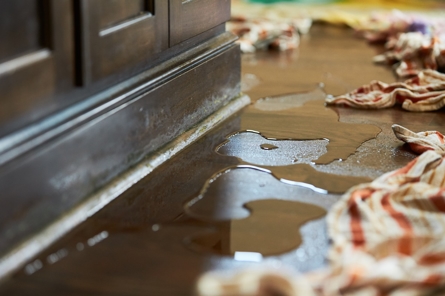
A water leak in your business should never be ignored. Whether from a plumbing leak, an appliance malfunction, or a leaky roof or windows, even a small amount of excess water can lead to significant water damage repair costs. That’s why it’s important to identify leaks and take quick action to correct them. Use the following tips from ServiceMaster Restore® to stop small leaks from becoming a big problem.
How to Spot Signs of a Plumbing or Roof Leak
Water can get into your building in a variety of ways, and two of the main culprits are roof leaks and plumbing leaks. One of the tell-tale signs of a leak in your plumbing system is an unexpected increase in your water bill. If your water bill seems high, inspect your building for the following:
- Leaking pipe joints or P-traps underneath sinks.
- Leaks around appliances that use water.
- Corrosion on supply lines to appliances and fixtures.
- Stains below supply line connections.
- Broken toilet tank flappers.
- Odd smells coming from drains, which may indicate a sewer leak.
- Warped or discolored flooring.
- Water stains on the walls and ceilings directly below bathrooms.
Water stains on walls and ceilings can also be indicators of a roof leak. Other signs of water damage can include a musty smell in the attic, peeling paint around skylights, deteriorating drywall, missing or damaged shingles, and damaged flashing.
What to Do if You Find Signs of Water Damage
Some leaks are, thankfully, fairly easy to fix. A leaky toilet may just require a new flapper valve, while a leaky faucet could need a new O-ring. If the leak requires more than a simple fix, however, call in a professional to address the issue and keep your water damage repair costs to a minimum.
In the event of a plumbing or appliance leak, you can mitigate the damage while you wait for the professionals to arrive. Start by shutting off the local water supply at the site of the leak. Here are the usual shut-off valve locations for some common fixtures and appliances:
- Sink: Just below the sink, next to the water supply lines. Sinks will typically have two shut-off valves, one for hot water and one for cold water.
- Dishwasher: Also under the sink, likely close to the sink shut-off valves.
- Toilet: Close to the toilet and near the floor, as part of the water supply line.
- Refrigerator with water and ice dispensers: On the supply tube running to the refrigerator, likely behind the refrigerator or under a nearby sink.
You can also lessen the potential for long-term damage by mopping or soaking up any standing water in the area of the leak. Keep in mind, however, that where there’s a water leak there’s often mold growth, so if you discover a mold outbreak it’s best to leave cleaning and remediation up to the experts. A professional water damage cleanup service like ServiceMaster Restore® will know exactly how to address the problem before it gets worse.
Even seemingly insignificant water leaks can be signs of a larger issue. Don't let these problems continue unaddressed. Take steps to identify and stop water leaks at your place of business, and then contact the remediation experts at ServiceMaster Restore to make sure your business stays safe and clean for everyone who walks through the door.
